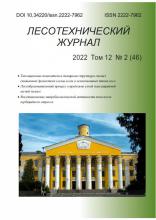Institute named after V.V. Dokuchaev
Russian Federation
Voronezh, Russian Federation
Voronezh, Russian Federation
Protective forests created by nest and a diagonal-group methods in its development differ from ordinary forest stands created by planting of seedlings. In Stone Steppe from 1948 to 1954, 23.6 ha of the nesting forests were laid, and in the period 1955-1964 19 experimental and production diagonal and group belts with a total area of 27.8 ha was laid in the territory of the Institute and its experimental farms. Carrying out cleaning cuttings has a significant difference from silvicultural treatments in ordinary forest belts.The studies were conducted in forest belts, with test plots (TP) with the measurements of trees (trunk diameter, tree height, crown height, crown diameter in two directions). A comparative analysis was carried out according to the test plots on the areas with cleaning cuttings and without them. The results of research allowed to determine growth rate of tree species under the influenced of cleaning cuttings and it was used to develop methods of forest management treatments in forest belts, created by biogroups.Contemporary condition of experienced middle-aged forest belts was also studied with different methods of creation and allocation of seats on the silvicultural area.
protective afforestation, mensuration, cleaning cuttings, protective height, reclamation efficiency.
Созданная система взаимодействующих защитных лесонасаждений в сухой степи лесоводами «Особой Экспедиции» уже более 120 лет нормализует и стабилизирует экологическую обстановку, образовав саморегулирующийся агролесоландшафт.
Особенности выращивания древесных растений узкими лентами в открытой степи определяют характер лесоводственных свойств защитных лесных насаждений. Ведение лесохозяйственных уходов в лесных полосах намного сложнее, чем в лесном массиве, где сложилась определенная микроклиматическая обстановка, но в лесных полосах, в зависимости от интенсивности изреживания, происходит повышение температуры воздуха и скорости ветрового потока, что ведет к уменьшению влажности воздуха и увеличению непродуктивного испарения влаги из почвы.
1. Kulik K.N. Razvitie lesorazvedeniya v Rossii [Kulik K.N. development of afforestation in Russia]// Dokuchayevske heritage: results and perspectives for the development of scientific agriculture in Russia: materials international. Scient. krnf. -Voronezh "origins", 2012-28-36.
2. Morozov G.F. Lesnie kulturi v Kamenno-Stepnom lesnichestve 1896-1900 gg[MorozovG.f. Forest culture in Stone-Steppe 1896-1900 lesnichestvoGg]//Tr. experienced forestry St. Petersburg, 1900-105-185.
3. Pavlovskii E.S. Viraschivanie zaschitnih nasajdenii v Kamennoi Stepi[Pavlovskiy, E.s. Growing protective plantings in Stone Steppes]-M.:Lesne. industry, with 1965-170.
4. Vavin V.S. Osobennosti rosta drevesnih porod na sklonah[Wavin V.S. peculiarities of growth of tree species on the slopes]//forestry, 2005, no. 3, pp. 40-41.
5. Pavlovskii E.S. Razvitie zaschitnogo lesorazvedeniya v Kamennoi Stepi v sovetskoe vremya[Pavlovsky E.S. development of protective afforestation in Rock Barrens in Soviet times]//Stone Forest Steppes. Scientific articles. Voronezh, 1967. c. 183-253.
6. Pavlovskii E.S. Viraschivanie zaschitnih nasajdenii v Kamennoi Stepi [Pavlovskiy E.S. Growing protective plantings in Stone Steppes]-M.:Lesne. industry, with 1965-170.
7. Ahtyamov A.G. Lesovodstvennaya i meliorativnaya ocenka diagonano gruppovih polezaschitnih lesnih polos na Yugo-Vostoke CChP [Akhtyamov A.g. Silvicultural and meliorative score diagonally-group forest shelter strips on the South-East of CChP]: synopsis of the DIS. Cand. with-x. Sciences-Volgograd, 1990, pp. 75-130.
8. Strobel G/ Eichen-Biogruppen. Wald. 2000. № 8. Pp. 390-398.
9. Mosandl R RationellePflegeyngerEichenbestande. Wald. 2000. № 11. Pp. 581-584.
10. Bréda N., Granier A., Aussenac G. Effects of thinning on soil and tree water relations, transpiration and growth in an oak forest (Quercuspetraea (Matt.) Liebl.) / Tree Physiol. - 1995. - № 15 (5). - P. 295-306. doi:https://doi.org/10.1093/treephys/15.5.295.













